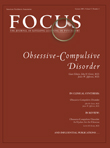Tic or Compulsion? It's Tourettic OCD
Abstract
A subgroup of individuals suffering from obsessive-compulsive disorder (OCD) frequently present to treatment with an atypical yet distinguishable array of symptoms akin to both Tourette's disorder (TD) and OCD. These individuals often receive standard treatments for OCD (or less likely, TD) that fail to address the blended features of their presentation. It is argued that these individuals would be better served, both psychotherapeutically and pharmacologically, by the adoption of a Tourettic OCD (TOCD) conceptual framework.
(Reprinted with permission from Behavioral Modification 2005; 29(5):784–799)



